WHAT'S NEW:
Deepsea Image Galleries on Multimedia page
(posted 9/15/98)
Eruption Confirmed!
New lava (rumbleometer stuck in flow) SE rift zone
(posted 9/1/98)
BACKGROUND:
Technology (ROV, ships, etc.)
Other 1998 Axial cruise reports
EXPEDITION:
Science Objectives
Calendar
Today's Science News
Participant Perspective
Teacher Logbook
EDUCATION:
Curriculum
Teacher Observations
Questions/Answers from sea
MULTIMEDIA:
(video clips, animations, sounds)
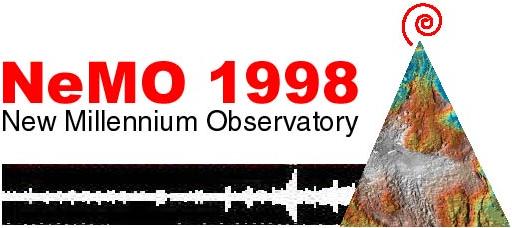
CHIEF SCIENTIST'S
WEEKLY REPORT Final Cruise Report - September 22
Bob Embley
Chief Scientist Final Report
It's been a few days since we're back on dry land, but I'm still "unwinding"
from the very intense and exciting experience of the NeMO98 expedition.
The last few days of the cruise was rather stressful because of the very
marginal weather conditions. ROPOS could not dive for about 36 hours because
of a large swell and high winds, and did not return to the water until
about 12 hours 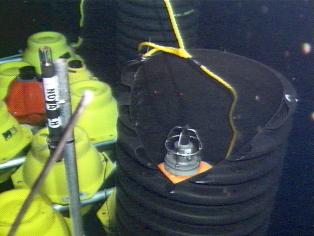 from the deadline
for beginning our voyage back to Victoria, British Columbia to end the
expedition.
from the deadline
for beginning our voyage back to Victoria, British Columbia to end the
expedition.
But what a dive (Dive 480) it was! We were able to return the refurbished
extensometer instruments (photo right: extensometer being pulled from
elevator for redeployment) to the seafloor at high points where they could
"talk" to one another over the next year. The elevator which carried the
instruments to the seafloor was recovered and the RON BROWN then towed
the ROPOS down to a vent site called CASM at the northernmost part of
the ccaldera. This site is at the interesection of the north rift zone
of Axial with the northern wall of the caldera. Hydrothermal systems tend to form at places where there are
intersections of faults or other structures such as the volcanic rift
zones because the rock is more fractured and forms pathways for the fluids.
The CASM site was first discovered in 1983 by a group of Canadian ( several
of whom were participants in the NeMO98 cruise) and U.S. Scientists
using the Canadian PISCES IV submersible (now decommissioned) and had
not been visited by a submersible or ROV for about a decade. CASM
is an acronym for "Canadian American Seamount" (Expedition). The
site had changed considerably since 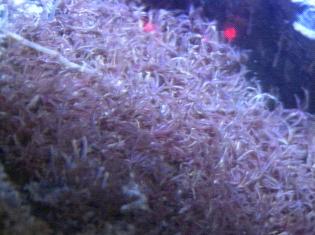 the 1980s. One spectacular vent was found lying on a crack in the wall
of the fissure just south of its intersection with the caldera wall. This
site was unique in that it had a dense colony of the "palm" worms gracefully
waving in the currents (photo left: field of palm worms
at CASM site). These polychaete worms are usually solitary or in small
groups; and its not clear why they would form such a dense colony at this
site. Another surprise was the presence of a new high temperature chimney
within the large fissure. Chimneys had been seen just outside the fissure,
but these had ceased venting high temperature fluids.
the 1980s. One spectacular vent was found lying on a crack in the wall
of the fissure just south of its intersection with the caldera wall. This
site was unique in that it had a dense colony of the "palm" worms gracefully
waving in the currents (photo left: field of palm worms
at CASM site). These polychaete worms are usually solitary or in small
groups; and its not clear why they would form such a dense colony at this
site. Another surprise was the presence of a new high temperature chimney
within the large fissure. Chimneys had been seen just outside the fissure,
but these had ceased venting high temperature fluids. 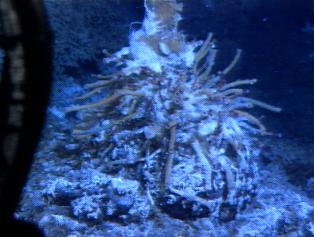 The new chimney had flow coming from small spires (photo right:
spire with tube worms) and intense lower temperature venting around its
base. With some difficulty, a high temperature probe was placed in one
of the vent orifices and left for the year. Two biologic samples, several
scans with the SUAVE, and sulfide sample was taken here. The vent also
was emitting what appeared to be bubbles similar to those reported on
earlier from the Mushroom vent at ASHES (photo below left)
Samples of this fluid taken with the gas sampler should
The new chimney had flow coming from small spires (photo right:
spire with tube worms) and intense lower temperature venting around its
base. With some difficulty, a high temperature probe was placed in one
of the vent orifices and left for the year. Two biologic samples, several
scans with the SUAVE, and sulfide sample was taken here. The vent also
was emitting what appeared to be bubbles similar to those reported on
earlier from the Mushroom vent at ASHES (photo below left)
Samples of this fluid taken with the gas sampler should 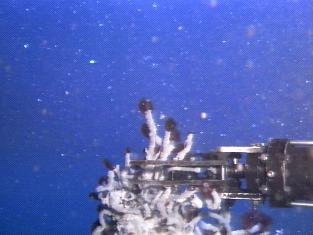 shed some light on the origin and composition of these bubbles.
shed some light on the origin and composition of these bubbles.
During the last week of the expedition (Dives 477 and 478), we
also were able to complete our goals on the new eruption site. A
time-lapse camera (experiment of
Verena Tunnicliffe) was placed
next to the Marker 33 site which will take pictures at 30 hour
intervals over the next year. The camera in conjunction with a
long-term Osmosampler
(photo below right: Osmosampler at marker 33)
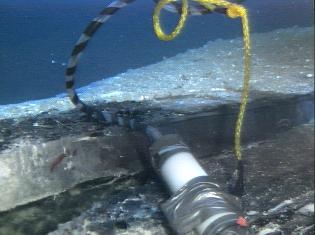 and temperature probe, will record the evolution of the chemical
and biologic systems associated with the eruption-related
hydrothermal system. An attempt at freeing the Rumbleometer from
the grip of the lava flow was, unfortunately, unsuccessful (photo below left).
Perhaps a more elaborate recovery effort
and temperature probe, will record the evolution of the chemical
and biologic systems associated with the eruption-related
hydrothermal system. An attempt at freeing the Rumbleometer from
the grip of the lava flow was, unfortunately, unsuccessful (photo below left).
Perhaps a more elaborate recovery effort
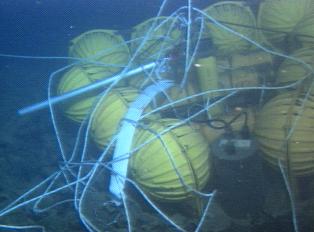 using the power of the surface vessel may be attempted next year.
using the power of the surface vessel may be attempted next year.
We also saw the first definitive site where tubeworms had been contacted and fried by the new lava (photo below left) on the eastern contact of the lava flow. Several dead clam shells near the contact suggest that it may have gotten too hot for them also.
NeMO 98 was an outstanding scientific success. On the last day of
the voyage, we all gathered together to discuss the results. A
feeling that everyone had was that the scientific success of the
expedition was primarily because of interaction between the
geologists, chemists, and biologists made possible because of the
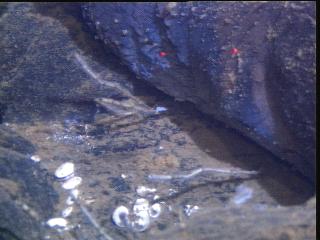 ability of the ROV to bring us all to the seafloor at the same
time.
ability of the ROV to bring us all to the seafloor at the same
time.
Our success was due not only to the extensive preparation by the scientific party, but to many others both at sea and on land who worked to ensure that the platform was prepared and run efficiently. This includes the seagoing staff of the RON BROWN, the engineers on shore who made sure the ship systems were prepared for the ROPOS, our funding sponsors ( VENTS Program, Sea Grant, the West Coast National Undersea Research Center, and the Canadian National Sciences and Engineering Research Council). The preparation and maintainence of this web page at sea was done through the hard work of Susan Merle and Gene Williamson and on shore by Andra Bobbitt. Mike Goodrich and Vicki Osis at the Hatfield Marine Science Center worked to ensure that the information was disseminated to the public and to the educational community at large. Gene and Mike were both volunteers, so a special thanks to them for their efforts.
We plan to continue this site with updates on the latest research results and plans for the next field season. We hope that's its been as much of a learning experience for all of you out there as it has been for us!
Sincerely,
Bob Embley
Chief Scientist, the NeMO98 Expedition
September 5 - September 12
Bob Embley
CHIEF SCIENTISTS WEEKLY REPORT
This week has gone by very fast, and, in the view of the NeMO98 science party,
has been a watershed in terms of scientific return with a remote vehicle. The
ability to interactively explore and sample the site of a recent deep-sea
eruption over several weeks is presenting new opportunities on a dive by dive
basis. All of us realize that the window of opportunity is limited and that we
have to make as much as we can out of each trip to the seafloor. The system
will no doubt undergo considerable change before the NeMO 99 expedition, and
every effort is being made to deploy all the monitoring instruments and to take
as many key samples as is possible.
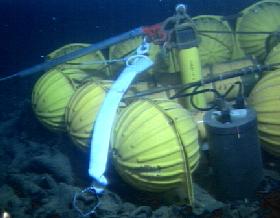
The dive last night capped off another exciting week. We began with the successful implementation of the first stage of a plan to recover the Rumbleometer that is now stuck in the lava flow. The ROPOS team carried a line and weight to the seafloor near the instrument and attached the line to the top of the instrument (see photo right). On a future dive, an attempt will be made to pull the instrument free of the seafloor with a line between the ROPOS "cage" and the instrument. Careful observations in the vicinity of the Rumbleometer suggests that the lava is about 6 to 8 feet thick so it's somewhat of a mystery why the instrument wasn't completely buried! ROPOS also transited over the site of the current meter mooring that never returned after being called back on Leg I of NeMO98. This site was also covered with new lava, and it's now pretty certain that the mooring was damaged and/or released by the lava flow.
A remnant from a visit to Axial caldera in 1996 or 1997 also provided
a "smoking rope" to the lava story. As was described here in reports from
the first part of the expedition, the position of ROPOS on the seafloor
is tracked with the aid of undersea sonar "beacons" called "Transponders".
After the transponders we used here in both 1996 and 1997 were released
(and recovered on the surface), 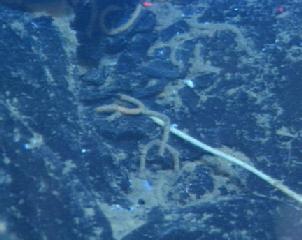 the thin nylon line linking the floating transponder to the weight on
the seafloor fell back to the seafloor. After locating this line draped
on older lava (we knew its position from a dive with ALVIN in July), it
was followed back to the contact where a close-up photo (photo left) clearly
shows it disappearing beneath the lava! It doesn't get much better than
that!
the thin nylon line linking the floating transponder to the weight on
the seafloor fell back to the seafloor. After locating this line draped
on older lava (we knew its position from a dive with ALVIN in July), it
was followed back to the contact where a close-up photo (photo left) clearly
shows it disappearing beneath the lava! It doesn't get much better than
that!
One of the most interesting characteristics of the new lava is a nearly
ubiquitous coating of what appears to be a brown to tan fluffy "mat" on its
surface. Without close examination, this coating (photo below right) makes the
lavas appear much older, so there was some initial confusion about distribution
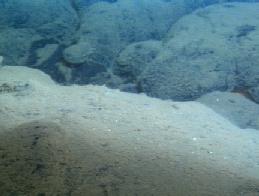 of new lavas. The primary goals of last night's dive were to map the
distribution of the new lava, and to collect samples of the basalt and the
various types of material coating its surface. On one of our tracks, we also
happened across a site that the biologists have been hoping to find since the
beginning of the dives. Growing around small holes in the lava where warm vent
fluid was emerging were pockets of tiny tubeworms, (photo below left)
representing the first stage in the recruitment of these ubiquitous vent fauna.
The sample taken at that site will probably be one of the most important
biological samples taken during NeMO98.
of new lavas. The primary goals of last night's dive were to map the
distribution of the new lava, and to collect samples of the basalt and the
various types of material coating its surface. On one of our tracks, we also
happened across a site that the biologists have been hoping to find since the
beginning of the dives. Growing around small holes in the lava where warm vent
fluid was emerging were pockets of tiny tubeworms, (photo below left)
representing the first stage in the recruitment of these ubiquitous vent fauna.
The sample taken at that site will probably be one of the most important
biological samples taken during NeMO98.
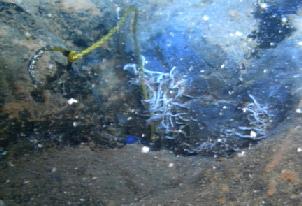
One of the most important developments during the past week was the success of the Vent Fluid Sampler. The success of this system over two long dives has provided much need samples for the NeMO98 chemistry and microbiology programs.
We also successfully recovered the "Extensometers" on the north rift and are now in a position to re-deploy them for another year on a later dive. Four of the instruments recorded data over more than a year and we are looking forward to seeing any sign of seafloor "stretching" during the 1998 event.
The dives at the ASHES vent field were very successful and provided
our first intensive look at this site on the opposite side of the caldera
from the eruption area. In contrast to the east side of the caldera, this
site is characterized by intense high-temperature venting (up to about
345 deg C!). The ASHES vents are fed by fluid that has probably been in
contact with the magma source that probably lies about 1 mile beneath
the caldera. The "fault" nearby provides a zone of crushed rock wherein
hot fluids can rise very fast without mixing with cold seawater and exit
the seafloor retaining their high 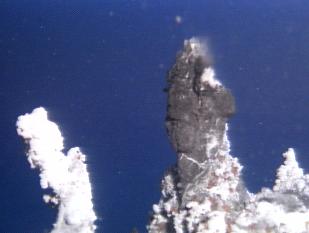 temperature.
The unique characteristic of ASHES is that it resides at a depth where
boiling occurs well within the range of hydrothermal fluids. Gas breaks
out of the fluid at about 348 deg C and very gassy fluids have been recovered
from this site as long ago as 1986. However, the bubbling vents seen by
the ROPOS video (photo right) were an unexpected surprise. The
jury is still out on how much ASHES was affected by the 1998 eruption
and earthquakes.
temperature.
The unique characteristic of ASHES is that it resides at a depth where
boiling occurs well within the range of hydrothermal fluids. Gas breaks
out of the fluid at about 348 deg C and very gassy fluids have been recovered
from this site as long ago as 1986. However, the bubbling vents seen by
the ROPOS video (photo right) were an unexpected surprise. The
jury is still out on how much ASHES was affected by the 1998 eruption
and earthquakes.
Only one more week in this expedition and much is yet to be accomplished. In particular we have a full schedule of deployments for our year-long monitoring systems and recoveries for experiments placed earlier during this expedition. Measurements made with a time-lapse camera, a chemical sampling system (Osmosampler), and numerous temperature probes will be our only link between the NeMO98 and the NeMO99 expeditions. (Stay tuned in 1999!)
The ROPOS is almost ready to go back in the water. Goodbye for now.
Bob Embley Chief Scientist of the NeMO98 Expedition
August 28 - September 4
|

|
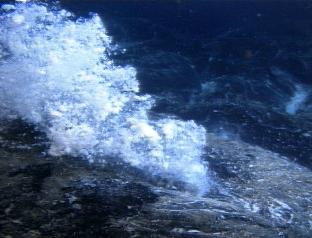
|
Photo of bacterial floc gushing from the new cracks in the seafloor. (photo: ROPOS NeMO 1998) |
The biological communities 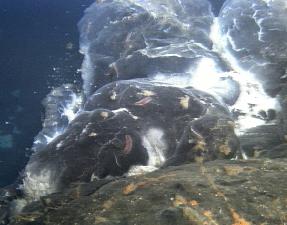 also reflect the extreme youth of the system. At vent sites in the young
lava, the biological communities are just getting a foothold on the new
basalt. Seven months after the event, these are dominated by white bacterial
mats and small red worms (photo at right: ROPOS NeMO 1998) (various types
of polychaete worms), while (in some cases) just a few hundred meters
away, there are more "mature" communities dominated by tubeworms living
in water venting from beneath the new lava and from older fracture systems
. It now appears that a large field of tubworms that ROPOS found in July
1997 near the Cloud Vent has been covered by lava and that many of their
close neighbors narrowly escaped being barbecued by the flowing lava.
Earthquake activity also has apparently had an effect on the biological
communities. At one site (originially visited in the late 1980s) a colony
of dead tubeworms was found attached to the top of a lava spire that had
also reflect the extreme youth of the system. At vent sites in the young
lava, the biological communities are just getting a foothold on the new
basalt. Seven months after the event, these are dominated by white bacterial
mats and small red worms (photo at right: ROPOS NeMO 1998) (various types
of polychaete worms), while (in some cases) just a few hundred meters
away, there are more "mature" communities dominated by tubeworms living
in water venting from beneath the new lava and from older fracture systems
. It now appears that a large field of tubworms that ROPOS found in July
1997 near the Cloud Vent has been covered by lava and that many of their
close neighbors narrowly escaped being barbecued by the flowing lava.
Earthquake activity also has apparently had an effect on the biological
communities. At one site (originially visited in the late 1980s) a colony
of dead tubeworms was found attached to the top of a lava spire that had
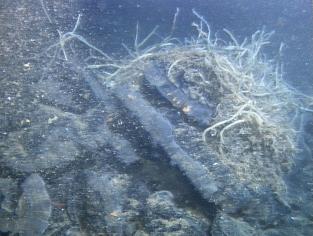 toppled over (see photo
at left) Apparently the tubeworms died when they were cut off from their
source of sulfide-rich vent fluid.
toppled over (see photo
at left) Apparently the tubeworms died when they were cut off from their
source of sulfide-rich vent fluid.
We know from previous experience at submarine eruption sites that there are dramatic changes during the first year after the eruption, so the next step is to deploy instruments that will monitor changes in temperature, biology, and chemistry over the next year. We are also fortunate that a group from Scripps Institution of Oceanography has deployed ocean floor seismometers in this area that will record small subsurface tremors over the next year. The ability to compare the changes we seen on our monitors with subsurface movements makes both experiments even more valuable.
We are also making great progress in making detailed maps of the eruption site with a new sonar system on ROPOS. To do this, ROPOS has to drive about 30 meters above the seafloor while the instrument "scans" back and forth making depth soundings. These maps are showing us a birds-eye view of the terrain which we are crawling over with ROPOS, vastly increasing our ability to interpret the images from the seafloor.
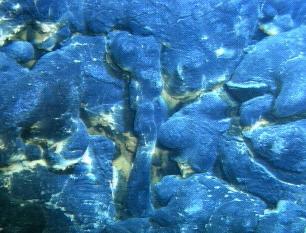 Our biggest problem
to date has been trying to keep up with the ROPOS team in efficiently
utilizing our time on the ocean floor. Last night several of us stayed
up to participate in a dive to the south of the caldera at a site where
high resolution maps showed an anomaly in the depth profiles believed
to be a new eruption (indeed there was one there!). (photo at left shows
new pillow lavas). Today I awoke to meet the group of scientists
planning a series of concentrated dives on the the high temperature vent
field lying on the east side of the caldera. This is the ASHES (Axial
Seamount Hydrothermal Emissions Study) vent site, which was explored thoroughly
in the 1980s by the submersibles PISCES IV and ALVIN. In between, there
were rock coring operations to
schedule and future dives to plan. By midnight while I sit here writing
this I'm keeping one eye on the video monitor in my room displaying the
scene on the seafloor almost one mile below us.
Our biggest problem
to date has been trying to keep up with the ROPOS team in efficiently
utilizing our time on the ocean floor. Last night several of us stayed
up to participate in a dive to the south of the caldera at a site where
high resolution maps showed an anomaly in the depth profiles believed
to be a new eruption (indeed there was one there!). (photo at left shows
new pillow lavas). Today I awoke to meet the group of scientists
planning a series of concentrated dives on the the high temperature vent
field lying on the east side of the caldera. This is the ASHES (Axial
Seamount Hydrothermal Emissions Study) vent site, which was explored thoroughly
in the 1980s by the submersibles PISCES IV and ALVIN. In between, there
were rock coring operations to
schedule and future dives to plan. By midnight while I sit here writing
this I'm keeping one eye on the video monitor in my room displaying the
scene on the seafloor almost one mile below us.
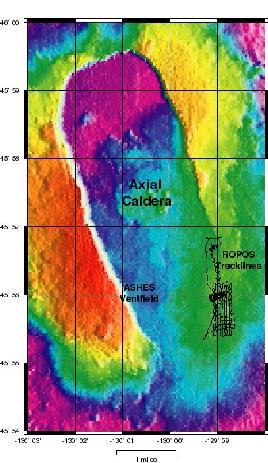 Perhaps the most satisfying part of NeMO to me has been the realization
of bringing a diverse group of scienctists to such an exciting spot on
the ocean floor. We've all been able to simultaneously visit a place on
the planet where the earth is being regenerated (Click map at left for
detailed dive map) and have been priviledged to debate the scientific
issues in realtime as we see and "feel" through the cameras and manipulators
of ROPOS.
Perhaps the most satisfying part of NeMO to me has been the realization
of bringing a diverse group of scienctists to such an exciting spot on
the ocean floor. We've all been able to simultaneously visit a place on
the planet where the earth is being regenerated (Click map at left for
detailed dive map) and have been priviledged to debate the scientific
issues in realtime as we see and "feel" through the cameras and manipulators
of ROPOS.
Many people have worked hard to get us all this far, from the engineers who modified the RON BROWN to use ROPOS, to those in headquarters and at the lab who we've depended on for so many things, including some of our colleagues who aren't here at sea with us, and to those agencies who provide the resources.